Earlier this afternoon, I was invited by North Vista Secondary School to give a talk on our splendid shores during their assembly.
And unlike my previous talk at Woodlands Ring Primary, I remembered to bring a camera this time round! Yehhhh....
However, you will notice that the photo above still couldn't make it. And that's because, while I remembered to bring a camera along, I forgot about the SD memory card! AAARRRGGGHHHH....
So in the end, I still had to take a photo of my audience with my miserable camera phone.
As you can see it the photo above, this time round I had a much larger audience compared with my previous talks.
And I must say the students at North Vista Secondary School were really GREAT! From the tag board, can see that a number of them have visited this blog too. Thanks!
Great to hear that the students enjoyed the talk! Sorry that I didn't really have much time to give more details about the shore animals highlighted in my slides though. Hopefully some of you can join our nature walks in future, so that I can properly share with you more about the interesting marine life we have on our shores.
And also hope that most, if not all the students who attended my talk today can remember what is LOVE Nature :)
Note:
If you are interested in my talks, just leave a message in the comments or the tagboard with your email address. Alternatively, you may visit the IYOR website for details on the other talks available and how to go about inviting the speakers.
Monday, March 31, 2008
IYOR Talk at North Vista Secondary
Saturday, March 29, 2008
Exploring Marina East
Today, a group of us Semakau guides decided to go Marina East to explore the marshland. Today was also the first time for the past 2 years I wasn't using my trusty Pentax W10 camera, and that's because - I LOST IT LAST WEEK!!!
If anybody picked up a Pentax W10 camera last Saturday, 22 Mar, around Pasir Ris or on bus 58, please leave me a comment on my blog. In the SD card of the camera, you should be able to find some nice shots of dragonflies, including one trapped in a web and a mating pair.
Sigh...
Borrowed my brother's Panasonic Lumix camera for today 's trip. Must say after using several compact cameras, I've realised that my Pentax probably still produces the best macro shots.
However, for wide shots, Lumix seems to be better though.
Here's the track we took to get to the marshland, which has many casuarina trees growing by the sides.
We eventually reached this pretty marshland with lots of freshwater plants and dragonflies. The number of species of dragonflies was really amazingly, and unfortunately I only managed to take photos of some of them because they were really alert, and I had problem getting close enough to take good shots.
This is probably a female Diplacodes nebulosa. A rather common species.
A male Acisoma panorpoides. Quite common in Singapore, and I've seen them even in urban areas like Ang Mo Kio and Bishan.
I think this could be the mostly commonly seen species in Singapore - Neurothemis fluctuans.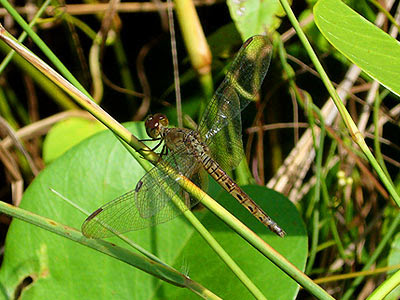
And here's the more plain-looking female Neurothemis fluctuans.
Not exactly sure which species is this, though I think it could be a female Crocothemis servilia.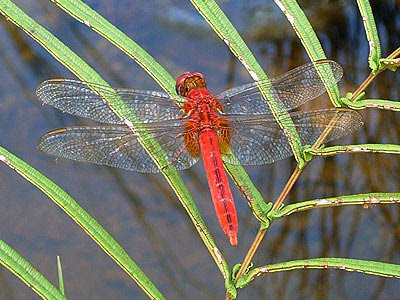
Here the male Crocothemis servilia.
A very pretty Rhyothemis triangularis.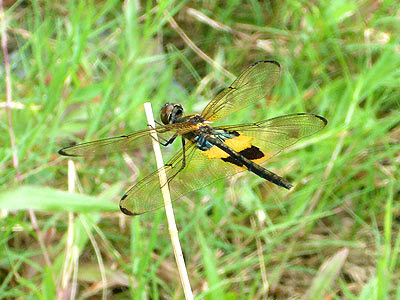
And from the same genus, Rhyothemis phyllis.
I was really excited to find the smallest dragonfly in Singapore, Nannophya pygmaea. The above is a female.
And here's a male Nannophya pygmaea.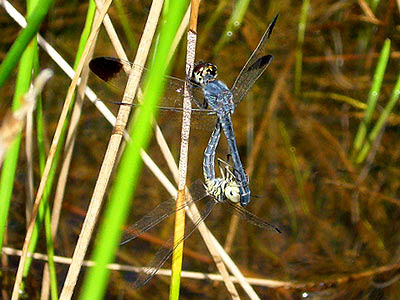
We also saw several pairs of dragonflies working hard for the next generation, such as the pair of Diplacodes nebulosa above.
We also saw many damselflies, but most of the are resting in the middle of the marshland, and since we didn't bring our booties today, I couldn't go into the water to take photos. This one looks like it's laying eggs into the water. I always have problem identifying damselflies because I find many of them to look really alike. Could this be a Ischnura senegalensis?
With so many dragonflies, we found several of their predators too, such as the blue-tailed bee-eater (Merops philippinus) above.
On the same tree, we spotted several pacific swallow (Hirundo tahitica) too.
And among the tall grasses, I also found this pretty St. Andrew's Cross spider. Can't remember the scientific name, but according to LK, this is supposed to be a rarer species compared to the other 2 species of St. Andrew's Cross spider we usually saw.
Though this bag worm looks really cute hanging off the trunk of a young casuarina tree.
We eventually hit the sandy beach area, and saw some of the usual shore plants, such as the sea lettuce (Scaevola sericea).
Growing on the sea lettuce plants were these interesting creepers, which I have no idea of the ID.
Indeed, we had yet another great trip today - lots of dragonflies, birds and other interesting wildlife, and of course, the blue sky just made everything look even nicer!
Will definitely come back again soon, with my booties, of course :)
Monday, March 24, 2008
Exploring Semakau with Duke University Students
This is quite a long-overdue entry actually, since we had this trip on last Friday. Haven't been feeling well over the past few days, and thus couldn't really find the energy to put up anything until today :P
Anyway, went to Semakau Landfill with Dr Dan, Dr Stan and their students from Duke University on Good Friday. Was rather happy to see Dr Dan again though I was struggling with a sore throat. It was always wonderful listening to Dr Dan as he shared his treasure trove of knowledge on the various marine organisms. I was their guide last year when they visited Sisters Island and Chek Jawa. This time round, however, I played the role of the coordinator for the trip, just to settle the boats and other logistics issues, while Ria had the pleasure of guiding him around the intertidal area of Semakau Landfill.
Here are our visitors from Duke University who just emerged from the secondary forest, getting ready to venture to the splendid shores of Semakau.
Semakau probably has the biggest seagrass meadow in Singapore. The seagrass meadow is an important nursery ground for many marine organisms, as there are lots of hiding places and food. Many of the seafood that we eat spend part of their life living among the seagrasses.
I was rather delighted to find this peacock anemone (Order Ceriantharia) among the seagrasses, since they were less common on Semakau compared with our northern shores.
Other Cnidarians we saw include the pretty anemone coral (Goniopora sp.) above and lots of other colonial hard corals. Each little flower-like structure you see above is called a polyp, and it is actually the coral animal! Colonial hard corals like this can sometimes have hundreds, if not thousands of polyps. The hard structure (or skeleton) you see is just like an "apartment" housing lots of little coral animals.
But sometimes, you get some lone rangers too, like the sunflower mushroom coral (Heliofungia actiniformis) above. All the tentacles you see above belong to one single coral animal (aka polyp). It is called a mushroom coral because the juveniles are attached to the substrate on a stalk-like structure, making it look just like a little mushroom! The coral will break away from the stalk when it matures though.
Other than the hard corals, we have plenty of soft corals at Semakau as well. Not sure about the exact ID for this one though. Unlike hard corals which have hard skeletons made of calcium carbonate, soft corals have a soft tissue connecting all the polyps.
Semakau also has no lack of sea anemones, which are relatives of the corals (from the same Phylum Cnidaria) , including some of the larger ones like the gigantic carpet anemone (Stichodactyla gigantea).
And sometimes, if we are lucky, we may even find the ocellaris clownfish (Amphiprion ocellaris) in some of them. Are indeed, we were rather lucky. The one above, probably got disturbed by the sound made by my foot steps, actually jumped on top of the anemone as I was walking past. I didn't even have to look for it!
Clownfishes and anemones share an interesting relationship. While most other fishes will be stung by the anemone's stinging cells when they touch its tentacles, the clownfish has a layer of mucus over its body that prevented the anemone from discharging its lethal stings. The fish will help the anemone by luring prey to it, increasing oxygenation, removing waste material, and protect the anemone from some butterflyfishes which feed on the anemone, while the latter helps the fish by giving it protection from predators and leftover food.
We can usually see lots of fishes at Semakau, and sometimes, that includes fishes that don't really look like a fish, such as this tigertail seahorse (Hippocampus comes). This was also the first time I saw this seahorse species at Semakau! Seahorse can usually camouflage themselves very well among the seaweeds, but guess this one's colour happened to more easily noticed :P
Another master of camouflage was this frogfish, probably a spotted-tail frogfish (Lophiocharon trisignatus). It usually slowly creeps around on its special fins (which look like paws) and catches (with its big mouth) little fishes or other small animals which didn't see it coming.
Semakau is also a wonderful place to find echinoderms, like sea stars and sea cucumbers.
Just like our other trips, we found several common sea star (Archaster typicus) before we enter the seagrass lagoon. These sea stars burrow into the sand to feed on any tiny edible organic particles.
At the rocky shore area, I was quite happy to find the cryptic rock stars (Cryptasterina sp.) again. These sea stars usually hide underneath rocks in the day away from the hot sun, and only come out to feed when it is darker. Can't remember what they feed on though. Probably algae, detritus or small clams?
Some of the others also found a few knobbly sea stars, which unfortunately I wasn't with them then to grab a few photos.
Fortunately, I managed to spot what I called the "Big Five" sea cucumbers of Semakau though.
One of the most common sea cucumbers on Semakau must be this - the sandfish (Holothuria scabra). This is usually the species that the Chinese eats during Chinese New Year, but they must be properly treated to remove the toxins before they can be consumed.
The second of the "Big Fives" - the stonefish sea cucumber (Actinopyga lecanora). We can usually find it among the rocks near the coral reef.
This is an ocellated sea cucumber (Stichopus ocellatus), which was only described in the 1990s! Sea cucumbers of this genus do not eject the sticky threads for defense, but they may eject their internal organs. When they are removed from the water for too long, they can actually "melt", become very limp and eventually disintegrate all together. However, if they are not too badly "melted", they are able to reverse this process and recover.
Also from the genus Stichopus is this dragonfish sea cucumber (Stichopus horrens). Also called the peanutfish sometimes in the sea cucumber trade, or the thorny sea cucumber or horrible sea cucumber, this fellow sure goes by many names :)
And the last, but longest, of the "Big Fives" - the synaptid sea cucumber (Family Synaptidae) .
But apart from the "Big Five", we had another surprise find - a red sea cucumber, which we thought could be an Actinopyga sp. related to the stonefish sea cucumber. First time seeing this on Semakau actually, and we found several of them among the seagrasses.
Moving on to the mollusc, and yet another interesting group with lots of fascinating animals.
Found this pretty living heart cockle (Corculum cardissa) among the seagrasses. Sadly, some people collect this shell while it is still alive, kill it and make the shells into little gifts. To me, this is certainly a heartless way to make a so-called "token of love".
Among the seagrasses, I also found this pretty noble volute (Cymbiola nobilis). These huge snails normally feed on clams and other shells. To feed, it wraps its prey in its huge foot, and waits until the exhausted clam opens up to breathe, which can take up to several days! The volute will then stick its proboscis into the shell and eats the flesh of its prey with its radula.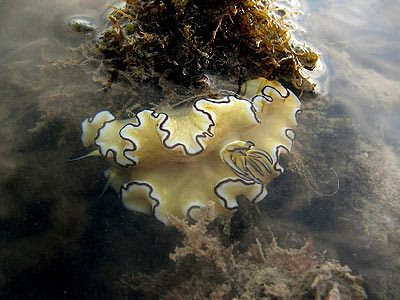
Also in the Phylum Mollusca, we have many beautiful little slugs called nudibranchs, and the above is one of them, a Glossodoris atromarginata. They are closely related to sea snails like the volute above, and basically, they are snails without shells. The flower-like gills exposed on its back was what gives nudibranchs their common name. Nudibranch means naked gills!
Found this cute little polka dot nudibranch (Jorunna funebris) on some seaweeds. The 2 little structures sticking out at its front end are its rhinophores, and nudibranchs use them to sniff out their prey. The polka dot nudibranchs are known to feed on blue sponges, so I was a little surprised when ST told me he saw one munching on some bryopsis seaweed! Could there be some tiny sponges growing on the seaweed? Or was it really eating the seaweed? I really have no idea...
We also saw a pair of Chromodoris lineolata getting really intimate. However, the position didn't look quite right though. Nudibranchs are hermaphrodites, meaning they have both male and female reproductive organs. They often fertilise each other when they meet in a 69 position. These two, however, are not in the standard 69 position which allows mutual fertisilation. It is known that among nudibranchs, sometimes one will assume a male role and the other a female role, so I guess it's possible that the two slugs above could just be doing that. (Update: Don't know what I was thinking when I wrote the above yesterday. The reproductive organs of the nudibranchs are always on their right side, so if they are facing the same direction side-by-side, their reproductive organs won't be able to meet, so they can't be mating here. So guess at the very most this could just be "foreplay", or they could be doing something else altogether.)
As it got darker, the slugs' distant relatives, the octopuses (Order Octopoda), also started appearing. Octopuses are known to be one of the smartest invertebrates, if not the smartest.
We also found a few cluster of squid egg capsules. While octopus and cuttlefish eggs tend to look like bunches of grapes, squid eggs tend to look like (pardon the crude comparison) bundles of inflated condoms.
Enjoying the darker and cooler surrounding were also several flatworms (Phylum Platyhelminthes).
And here's one of the commonly seen flatworms (Acanthozoon sp.). Flatworms are so flat that they can easily squeeze into small crevices to hide from predators or to seek out prey, which could be little shrimps and worms, or even sponges or ascidians.
Indeed, this Semakau trip has again been a very successful one. Hope Dr Dan, Dr Stan and the Duke University students have enjoyed themselves too.
See also:
- Pulau Semakau with Dr Dan and friends by Ria.
- Good Friday at Pulau Semakau by CH.
- Mini Cowry at Semakau by ST.
- Day 5--Semakau by Dr Stan.
Tuesday, March 18, 2008
IYOR Talk at Woodlands Ring Primary School
Today, I was invited by Woodlands Ring Primary School to give a talk on our wonderful shore life and marine conservation as part of the International Year of the Reef (IYOR) 2008 activities :)
My audience for the day were about 80 enthusiastic Science and Environment Club students and their teachers. Pardon the poor quality of the photo, as I forgot to bring my digital camera, and had to use my primitive mobile phone camera :P
Basically, the students were introduced to the various marine life that can be found on our shores - it's just like going for one of my guided walks minus the walking and interaction with the nature stuff. Well, nothing beats the REAL experience of going out to our shores to see and feel things yourself, but guess this is still better than reading from a book which doesn't come with much interaction :P
And sure enough, the students made full use of this opportunity to interact with the speaker, that is, me!
My talk usually last for about an hour, but the students were so interested in the various local marine life, that they kept asking questions in between and the session eventually dragged on to about 1 hour and 45 minutes! And even then, I had to rush through my last few slides as they had to leave school at 6pm. It just felt great to know that so many of our younger Singaporeans were so keen to find out more about the wildlife our splendid shores support!
Here's a quick collage of some of the things highlighted during my talk:
All in all, it was a great experience sharing what I know about our shore life with such a wonderful audience. Sure am looking forward to my next talk at the end of the month :)
If you are interested in my talks, just leave a message in the comments or the tagboard with your email address. Alternatively, you may visit the IYOR website for details on the other talks available and how to go about inviting the speakers.
Monday, March 10, 2008
Exploring Semakau with Dr Yaacob
 Last Sunday, we had a few special guests joining us on our Semakau intertidal walk. Dr Yaacob Ibrahim, Singapore's Minister for the Environment and Water Resources, finally managed to squeeze out some time from his busy schedule to pay us a visit with his family and friends!
Last Sunday, we had a few special guests joining us on our Semakau intertidal walk. Dr Yaacob Ibrahim, Singapore's Minister for the Environment and Water Resources, finally managed to squeeze out some time from his busy schedule to pay us a visit with his family and friends!
The boat operator got us my favourite boat this time round, with nice little cabins and an open deck, which allowed us to have to great view of the surrounding on our way to the landfill island. We started the boat ride all sunny and bright, and just as we were reaching Semakau, it started pouring. Fortunately, the rain stopped when we were about to start the landfill tour.
We started the boat ride all sunny and bright, and just as we were reaching Semakau, it started pouring. Fortunately, the rain stopped when we were about to start the landfill tour.
The southern-most point of Semakau Landfill is also the southern-most point of Singapore's land that the public can access. We wasted no time in taking a been-there-done-that group photo.
As we were in the van going towards the secondary forest, we saw 3 great-billed herons (Ardea sumatrana)! Great-billed herons are the tallest birds in Singapore. Unfortunately, they were too far away for me to grab a good shot.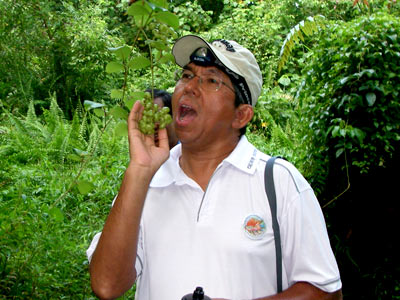
As we were walking through the secondary forest to head to the shore, we saw this pretty vine with cute little fruits dangling off a branch. I think someone told me before that they are related to grapes, but are not edible. Can't remember the name though. Dr Yaacob showed a lighter side of him immediately and struck a comical pose for us :D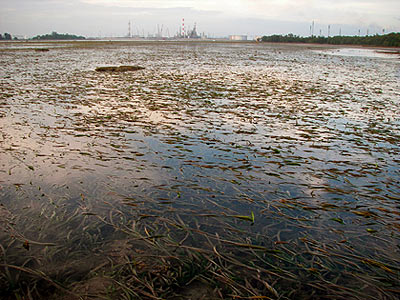
We soon reach the shore, and after crossing the sandy area with lots of fiddler crabs, hermit crabs, creepers snails, sponges, and a pair of coastal horseshoe crabs, we finally reached the beautiful seagrass meadow. Semakau probably has the largest intertidal seagrass meadow in Singapore, and it stretches for kilometres! Seagrasses is the home for many marine animals, especially the juveniles, as there are plenty of food and hiding places. In fact, many of the seafood we eat spend part of their lives in seagrass meadows!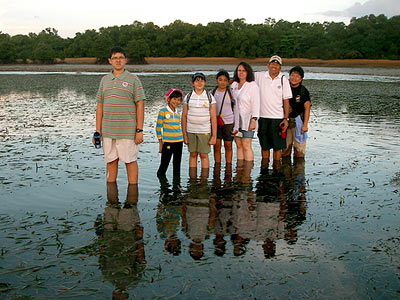
Here's the usual traditional shot of Dr Yaacob, his family and friends crossing the seagrass meadow...
And here's the wacky one! :P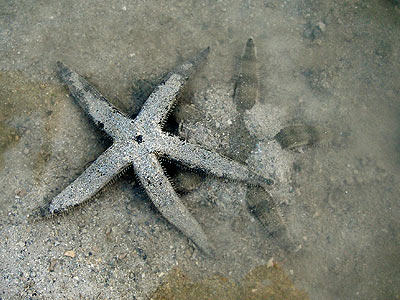
And just after we crossed to the other side, we were greeted by countless common sea stars (Archaster typicus). These sea stars used to be very common on our shores, but we hardly see them on mainland Singapore now, probably due to the destruction of their habitats and over-collection.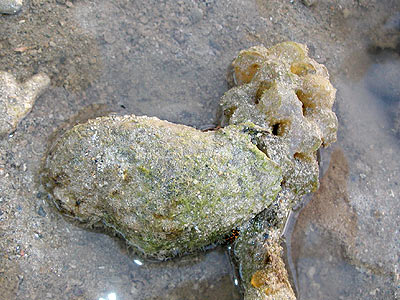
Just the day before, we saw a juvenile noble volute (Cymbiola nobilis), and this time, not only we saw a juvenile again, we also spotted a mother laying eggs! Unlike many other marine snails which hatched in the form of planktons drifting with the currents, baby volutes hatch as little crawling snails. Thus, you don't usually find a particular species in a wide geographical range.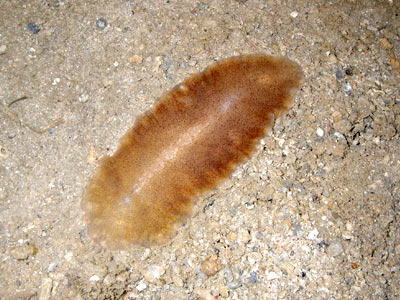
This is the first time I saw this interesting flatworm. It's somewhat translucent and had tiny little brown spots. Near the front end of the flatworm (it's crawling downwards in the photo), you can see a whitish round spot, which is probably the eyespot where numerous eyes form round clusters. The eyes can't really detect images, but are sensitive to changes in light direction and intensity. Other eyespots can be found on its pseudotentacles at its front end too. The other guides later also found us a few of the usual Acanthozoon and Pseudoceros flatworms.
Heard from the hunter-seekers that they found lot of Chromodoris nudibranchs (Chromodoris lineolata). This is actually a sea slug, and the name nudibranch means naked gills, referring to the flower-like gills you can see on its back.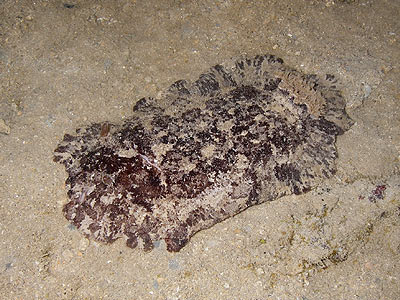
Here's another nudibranch, probably a Discodoris lilacina. Have only seen it once on Semakau before, but guess there could be more of them since they're so hard to spot, being so well-camouflaged among the rocks and coral rubble.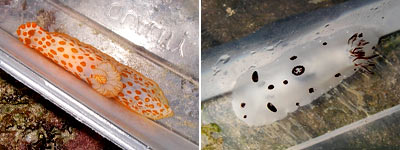
More nudibranchs here, with the orange-spotted nudibranch (Gymnodoris rubropapulosa) on the left, and the polka dot nudibranch (Jorunna funebris) on the right. The former is a fierce slug eater, and eats even fellow slugs of the same species, while the latter feeds on sponges.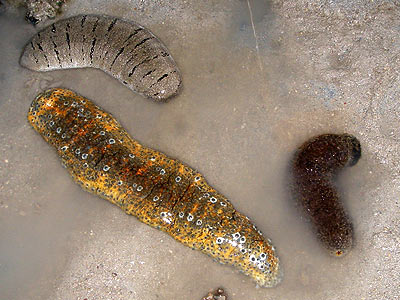
It turned out to be a great day for sea cucumbers, and we've 3 different species here. Anti-clockwise from top left, we have the sandfish sea cucumber (Holothuria scabra), the ocellated sea cucumber (Stichopus ocellatus) and stonefish sea cucumber (Actinopyga lecanora). Getting in-touch with nature is just so much more exciting that just watching it on TV!
Getting in-touch with nature is just so much more exciting that just watching it on TV!
After some quick photos, we quickly put them back into the water, because sea cucumbers use sea water to transfer nutrients in their body, and also to move their little tube feet. Thus, they should never be removed from water for too long, or they will get very stressed.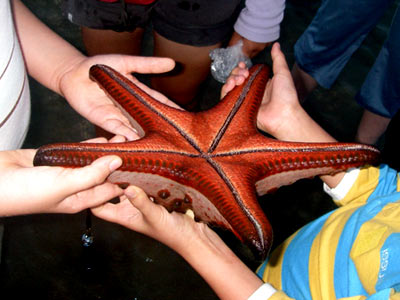
We also found a huge knobbly sea star (Protoreaster nodosus). This brilliantly coloured sea star used to be rather common on our shores too, but unfortunately were getting rarer these days as well due to the loss of their habitat and probably poaching as well. Our visitors managed to take a quick look at its underside and take some quick photos before putting it back into the water. Sea stars are related to the sea cucumbers, and so they get very stressed too if they are removed from water for too long.
We soon had to turned back to shore as the tide was returning, but not before we managed to see a few cute octopuses (which I didn't managed to take any photos) and lots of beautiful corals.
This was certainly a very enjoyable experience for me, and I hope our special guests enjoyed it too.
For me, it's also a rather unique experience, having the opportunity to interact with Dr Yaacob, and seeing the family man in him - the caring husband, loving father and also, as a fun-loving friend - instead of the minister and politician we usually saw on TV or papers.
All in all, another GREAT trip! :)
See also:
1. Semakau Inter-Tidal Walk on 9 March 2008 by JL
2. Semakau Inter-tidal Walk on 9 March 2008 by ST
3. Semakau Walk Critters! by SJ
4. Minister on the Shore! (Semakau Walk) by SJ
5. My first OJT at Semakau by KS
6. Love is in the sea... by JS
